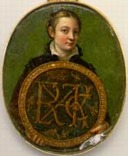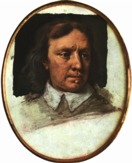
Often refers either to a small picture illustrating a manuscript, or to a portrait painted on paper, ivory, or porcelain.
The word "miniature" originated in the name of a kind of paint. The brilliant red color monks used in decorating medieval manuscripts was called minium (red lead) in Latin, and that art was called miniating. A picture illuminating the text — necessarily small because of the limited space available — was thus called a miniature.
Examples of the second sense of miniature:

Petrus Christus (Netherlandish, active by
1444, died 1475/76), Head of Christ, c. 1445, oil
on parchment, laid down
on wood, overall 5 7/8 x 4 1/4
inches (14.9 x 10.8 cm), parchment 5 3/4 x 4 1/8 inches (14.6
x 10.5 cm), Metropolitan Museum of Art, NY.

Sofonisba Anguissola (Italian, c. 1535-1625),
Self-Portrait, c. 1555, oil
on parchment, 3 1/4 x 2
1/2 inches (8.2 x 6.3 cm), Museum of Fine Arts, Boston. The artist holds a medallion inscribed in Latin around the rim: "The maiden Sofonisba Anguissola,
depicted by her own hand, from a mirror, at Cremona." Inside
the circle is a cryptogram
whose entwined letters
are included in the name of Anguissola's father, Amilcare. The
meaning and original purpose
of this enigmatic portrait remain a mystery.
See Baroque,
circle, cryptic,
feminism and feminist art, mirror, oval,
and self-portrait.
![]()
India, Mughal dynasty, A Lady and a Gentleman Converse, from
the Tuti-Nama, c. 1580, opaque
watercolor on paper,
heightened with gold; mounted on a later album page; Persian
text in nastaliq script; chapter
heading in kufic script, Worcester Art Museum, MA. See calligraphy.

Riza-i Abbasi (Iranian), A Convivial Party, 1612, paper,
gouache, gold, Hermitage Museum, St. Petersburg,
Russia. See Islamic
art.

Samuel Cooper (English, 1609-1672), Oliver
Cromwell, Lord Chief Protector of England (1599-1658),
watercolor on vellum,
oval, about 2 3/4 x 2
1/4 inches (70 mm x 57 mm). Cooper was one of the leading miniaturists of the
17th century. Oliver Cromwell commissioned
Cooper to paint his portrait
miniature -- famously realistic,
because Cooper captured the thinning Cromwell literally "warts
and all."

James Gillray (English, 1757-1815), A Connoisseur
Examining a Cooper, c. 1795, stipple
engraving.
England's King George III — a connoisseur — is seen examining Samuel Cooper's tiny portrait of Cromwell
by candlelight. Gillray expresses
his disdain for the king by pushing this caricature of him toward the grotesque.
Gillray's engraving was produced shortly after the American and
French revolutions, when George III had grown unpopular. The
artist implies that this king could suffer a fate similar to
that of King Charles I: beheaded by Cromwell's supporters in
1649.
![]()

Henry Benbridge (American, 1743-1812), Portrait of a Gentleman, c. 1770, watercolor on ivory, 1 1/4 x 1 7/8 inches (3.2 cm. x 4.8
cm), Metropolitan Museum of Art, NY.

Walter Robertson (American, c. 1750 - 1802),
General George Washington, 1794, watercolor
on ivory, 3 15/16
x 3 3/16 inches (10 x 8.1 cm), Cincinnati Art Museum, OH.
Also see book, calligraphy, codex, incunabulum, scriptorium, and tricesimo-segundo.
https://inform.quest/_art